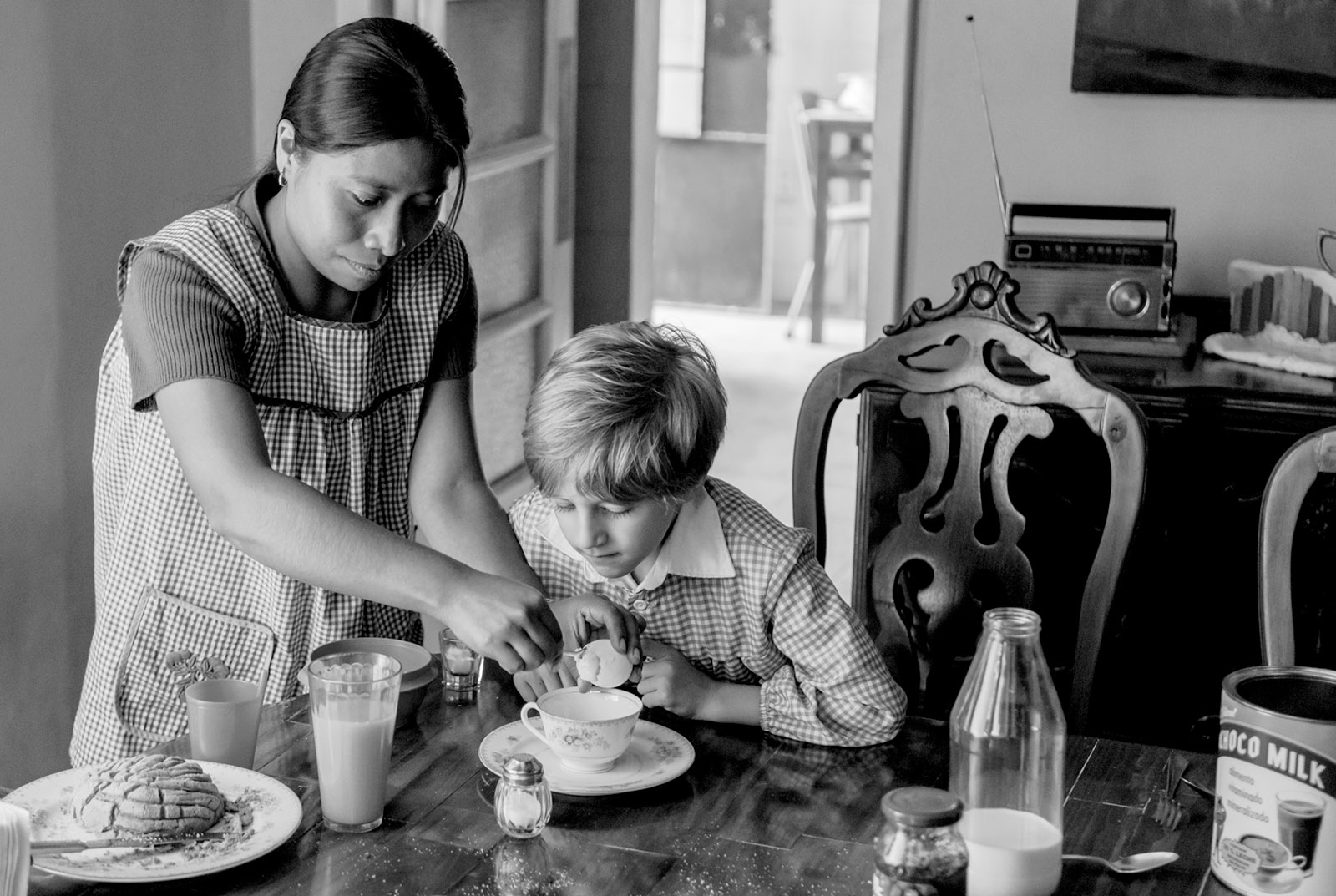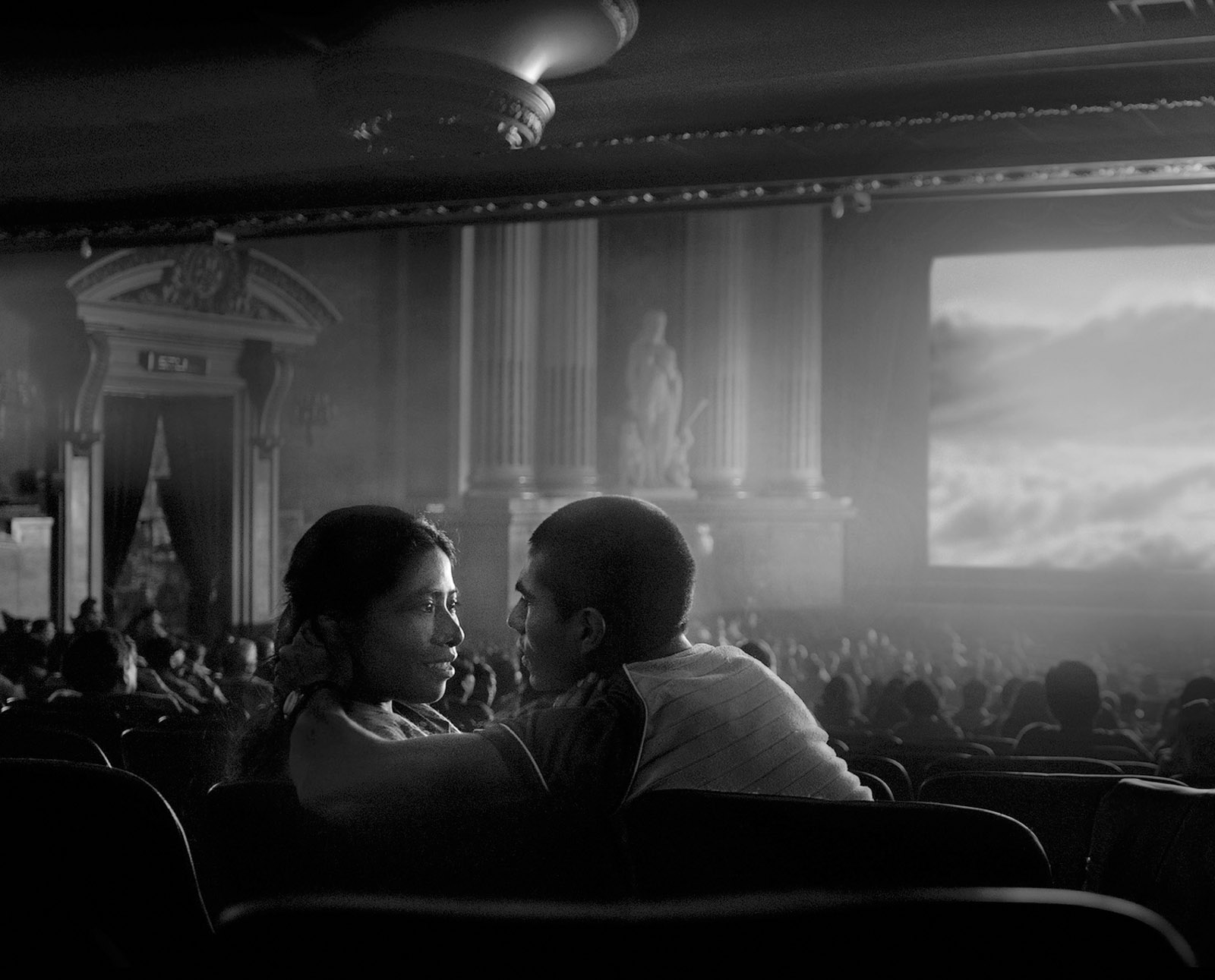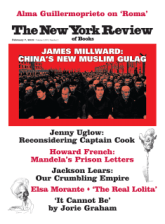Water comes over the screen in waves for long minutes as the film opens. Offscreen, we hear the scrubbing of a straw bristle brush, as soapsuds float in and out of the frame, and at last the shot widens to reveal a young woman, tin bucket in one hand, long-handled squeegee in the other.
The tiled area under the brush is the carport of a home in one of the older parts of Mexico City, and if you’re a Mexican viewer you’ll know without thinking that the person with the bucket is a servant, doing the daily morning clean-up. You’ll know her occupation even before you really see her face because she is dark-skinned and too poorly dressed to be anything else in a house of that size, and because she exudes an air of calm and ingrained patience. What you won’t necessarily realize is that she, Cleo, is the protagonist of the film, because no Mexican film, other than the farcical and offensive comedies featuring la India Maria, has ever had a household servant at its center.
(It is only later that we’ll understand that what Cleo is so busily scrubbing away is the filthiest of all filth: dog shit, supplied in large quantities by Borras, a cheerful mutt who is the house dog, but not exactly the house pet. American-style pets didn’t really exist in Mexico back in 1970, when the film begins.)
For an American viewer—or at least for those viewers who have never met or been a domestic employee, known anyone who employs a full- or part-time servant, or hired a woman to provide domestic help—reading the character of Cleo, and by extension those of her employers, is possibly even more complicated. But start by looking carefully at the house: it is in the no longer elegant Roma neighborhood. Large but not enormous, and somewhat run-down, it’s certainly not luxurious. In addition to Cleo and her best friend, the household cook, seven people live here: four children, who share two bedrooms; their father, who is a doctor, and his wife, a chemist; and the wife’s mother. The furniture, heavy and dark, most likely belongs to the wife’s mother, as, in fact, the whole house probably does. (How do I know this? Because in the 1960s professionals like Cleo’s employers lived in newer, more comfortable houses in the suburbs, or in apartments that were cheaper and easier to care for.)
This is the house that Alfonso Cuarón, the director of Roma, grew up in. Or at least it’s the recreation, meticulous to the point of madness, of that house. And this is the story of Cuarón’s memory of a turbulent time in his childhood. The movie is shot parallel to the action, as if the camera were the ghost of Cuarón revisiting his childhood and looking on it silently, with the compassion and distance we are sometimes lucky enough to muster for our sinning youth and that of our parents. The hero, though, is Cleo, the nanny whose affection, unlike the parents’, is never wavering or disconcerting, and who, unlike a different, infinitely tiresome nanny on other screens around the city, performs true miracles. She had been on Cuarón’s mind for years: in his early masterpiece, Y tu mamá también (2001), one catches a glimpse of Liboria Rodríguez, the real-life model for Cleo, carrying a tray of food up a long flight of stairs to the rich kid played by Diego Luna, and handing it to him with an affectionate pat. (The Luna character is nearly oblivious of her care, her effortful journey up the staircase, her love for him, her hard work. Almost, but not quite; later in the film, as the car he is riding in passes a road sign pointing to Tepelmeme—Liboria’s hometown in real life—the Luna character notices it and reflects that this is the place the nanny he once called mamá came from.)
So who is Cleo? The subtitles tell us that the language she speaks with Adela, the cook, is Mixteco, so we know she is from a desperately poor highland area of southern Mexico comprising parts of the states of Puebla and Oaxaca. Her small size and the shape of her face tell us so, too, because the dozens of nationalities, languages, and customs of the first peoples in Mexico were as highly distinct as those of Europeans; there were, among others, long-boned Apaches in the north, Purépechas and Mexicas in the middle, and delicately built Zapotecs, Mayas, and Mixtecos in the south. (Both the real-life Liboria and the first-time actress who plays her, Yalitza Aparicio, a recently graduated preschool teacher, are Mixtecas. Aparicio was living in her native village in the highlands of Oaxaca when Cuarón recruited her to play Cleo.)
Advertisement
Lastly, Cleo is part of a family, or rather two. She belongs to a family back home, of course, but Roma is about the family she works for and lives with. Nannies everywhere are often considered part of the family, and families tend to reflect the societies of which they are the building blocks. In this particular case, Cleo is and will remain throughout the film—and, we understand, beyond it, as the real-life Libo has remained to this day—part of a hierarchical, exploitative, unequal, unstable, and nevertheless unstintingly loyal and, yes, loving, Mexican family.
Cleo and Adela (played with relaxed authority by another Mixteca nonprofessional actress, Nancy García) are probably kin. Adela, the older of the two, may have emigrated first to the city, in search, like Cleo, of a life better than the parched subsistence she and her family eked out back home, with its grueling workload of endless days that transformed women into hags before they turned forty. But Cuarón is not interested in portraying Cleo anthropologically: he wants to show us what she was to him, and to tell the story of Mexico City and what happened to Cleo the year that his own family shattered.
Life in la capital is both exciting and pleasurable for the shy Cleo and her more forward friend. They share a crowded room at the back of their employer’s house—how lonely to sleep by yourself! The work is delightfully easy compared to the punishment they left back home, the money better—they can buy a sandwich and drink soda whenever they want! And they are lucky to have stumbled on good patrones—they get a day off every week. Like any live-in nanny—like any full-time housewife, for that matter—Cleo’s days are as long as those of the four children she cares for. She sings them to sleep, nuzzles them awake, is nourished by the way their eyes melt with love when they say goodnight. Cleo doesn’t say much when she is around them, in part because her Spanish is hesitant, but alone with Adela the two chatter and giggle endlessly in Mixteco about boyfriends, the patrones, and the children.
The thrill of going regularly to the movies in one of the ornate movie palaces that dotted the city back then is superseded only by the excitement of romance. Cleo falls for a wised-up capitalino, Fermín. We should know he’s bad news from the moment he guzzles her soda on the sly before rejoining her on their date, but, like her, we are dazzled by his grace and sheer beauty. Fermín tells Cleo what Cuarón needs us to know; he is a child of a shantytown on the city’s eastern outskirts, Nezahualcóyotl. Today, it is a full-blown city of one million people, but back in the movie’s time it was a vast expanse of reeking mud—no paved roads, streetlights, water, or phone service—where immigrants from the desperate countryside often found a first foothold.
Fermín drank too much, huffed glue, was generally a mess, he tells Cleo, but then he discovered the martial arts of which he has just given us such a ravishing demonstration. He is a different, more powerful man now. Of course, he gets Cleo pregnant. Of course, he walks out on her the moment she breaks the news to him. Of course, the day she travels all the way to Nezahualcóyotl, where he is part of a kung fu stick-fighting group, he denies that the child could be his and calls her a whore. Meanwhile, seeing garbage trucks parked behind the field where he has been training, we realize that Fermín is a garbage worker.
And so, now that we have been introduced to Roma’s main characters, calmly and in some, but not too much, detail, the action lumbers forward like a tank that takes a fair amount of time to roll up to cruising speed, but then is almost impossible to stop. The crucial events take place on Corpus Christi, a movable feast in celebration of the transubstantiation of the body of Christ that, in 1971, fell on June 10. An extremely pregnant Cleo and the matriarch of her employers’ family go together to a furniture store, to buy a crib for Cleo’s expected baby. In Cuarón’s obsessive recreation of the real-life events of Corpus Christi, we see the two women pass through a street scene that the inhabitants of Mexico City have come to know well: roads lined with military armored cars, police vans, heavily armed police, and tense men in civilian clothing carrying not-so-concealed weapons.
Advertisement
Also walking toward broad Ribera de San Cosme Avenue are increasing numbers of young people, on their way to join a march that is gathering at a crossroads a couple of blocks away. In real life, less than three years had passed since the gruesome Olympic Games massacre at Tlatelolco Plaza, and the Corpus Christi march was the largest protest since that event. At the start of the march, demonstrators sang the national anthem, which, in the movie’s brilliant soundscape, we hear approaching offscreen. A growing murmur of panic rising from the street draws the shoppers in the furniture store to the windows.
Dazed, they watch the protest break up under the assault of men wielding heavy sticks and firing guns. Marchers scatter like a column of ants threatened by a torch, and now their utter panic is brought inside, into the store, to the very threshold of Cleo’s body: a clutch of murderers in civilian clothes has burst into the showroom, guns pointed at a terrified protester. The young man is shot and falls dead; another gun is pointed at Cleo, and at the other end of it is a face whittled by adrenaline to a feral point: Fermín. Of course: those of us who remember the Corpus Christi massacre’s history know that many of the men who attacked the demonstrators, killing dozens, were garbage workers controlled and trained for the occasion by goons from the ruling party (and, the movie implies, by US operatives). In the shock of recognition, Fermín retreats, Cleo’s water breaks, chaos ensues.
When I was a child there was always a nanny. My parents were broke more often than not—breakfast and supper might frequently be a bread roll and black coffee—but there was always a nanny, and no matter how sporadically we paid her, she never left: it was the order of things. Carmela fed me breakfast when my parents weren’t around. She took me with her wherever she went: to market, to shop for the day’s meal; to the shoe repair shop; to the park, where we sat on a bench to watch the pigeons while I clung to her, blurting questions; and even to faraway Xochimilco, where she had relatives, and where, on a dusty road in the middle of cornfields and narrow canals, I saw my first funeral—a quavering chant in the air, a dozen mourners, the men in straw cowboy hats, the women wrapped in rebozos, everyone holding a flower or a candle in the late-afternoon light, and at the center, a small white coffin bearing the angelito, the dead child.
There is a dead child in Roma, too, stillborn but perfect, that an exhausted Cleo watches as it is carefully wrapped in its little shroud. In the past, angelitos flew from their mothers so often as to make it an ordinary occurrence. My own grandmother gave birth to twelve children, of which six survived. Women were always pregnant, and it was up to the father, if the marriage was stable, to find ways to feed five, or eight, or twelve children. Or the woman might die young, frequently in childbirth. There would most likely be a second marriage for the father, and the new wife might want to ensure sustenance for the new family by attaching the husband more to her own brood than to the one from a previous union.
Families are fragile and even dangerous things, as Cleo learns: throughout her pregnancy she has watched the breakdown of her employers’ marriage. The husband, whom we first see arriving home in an ostentatious Ford Galaxie almost too big for the driveway, has found a new love: his heart commands him to abandon his wife and family, and he follows its orders. (Cuarón, directing the film of Cleo’s life, which is also that of his life as a child, has his little revenge: the Galaxie drives straight into a neglected pile of dog shit, and the father himself steps on another of the dog’s efforts as he leaves home for the last time.)
As Roma’s producer, writer, cinematographer, editor, and director, Cuarón may have asked himself as he began to conceive this film how much of his love song to his nanny would be understood outside his country, or whether a commentary—a translation, really—would be a necessary complement for some viewers. What is evident is that he has made no concessions to foreign audiences, for whom every second of the movie is unavoidably not as transparent as it is to Mexican viewers—or for whom the film might not provide enough background to see that the central problem Cuarón is dealing with is the twisting nature of love.
I once interviewed a couple of dozen domestic servants about their work. It was hard to get young empleadas to talk to me, particularly if they were from the countryside: the fear of sounding ignorant, of saying the wrong thing, of losing their job, of speaking, made most of the young women I approached simply turn away from me. But the older women had plenty to say. A surprising number stated that they were happy with their families; an overlapping majority had loud complaints about their salaries. But what I heard most frequently was the rage they felt at previous employers who had fired them with no warning or thought for their feelings. What about the children? they would ask. They fire us, we have to abandon them, and then you have to learn to love a new set of children, and you’re always afraid you’re going to be fired all over again and lose them. One woman cried as she explained this. “They never think about the fact that we love the children,” she said.
What no one talked about, unless I asked, and then not much, was the fact that, if they were live-in nannies, most of them had their own children, who were being raised at home in faraway Oaxaca, or Hidalgo, or Guerrero, by grandmothers or aunts.
How, I wondered afterward, does a woman’s heart unravel once she is in this impossible fix? She is working to guarantee her children a better future than the one she faces, but while her child might be at home eating stringy meat and watery soup, she herself eats like an empress. The children she cares for loudly demand the latest-model cell phone every year, while at home a single phone with a cracked screen might be shared by an entire family. Her employers’ children will go on to top universities, learn smart things, move easily through the world; her children try to get enough education to graduate from the menial jobs their parents hold. She knows the household children intimately; her children do not know her very well at all. Does she resent her employers’ children for this monstrous difference? Or—let us face the thing squarely—does she love them more than her own? That the women I interviewed could love the children they cared for—and love them, in fact, to the point of heartbreak—was to me nothing short of miraculous.
And thus does Cleo love her family’s four children. She performs a miracle for them, even, saving two of the four from drowning during a trip to the beach, although she has never seen the ocean before and does not know how to swim. But here’s the thing that Cleo can admit at last: she did not want to bear her baby, Fermín the assassin’s stillborn child, and the guilt has been threatening to drown her. She did not want to give birth to her, pobrecita, poor little thing, she blurts out after she has performed her redeeming miracle. No la queria. She loves the four children more.
So much happens in Roma. It is so bursting with life, Mexican life! Geese copulate at a New Year’s party, men fly out of cannons, dogs shit and jump for joy, street vendors call out their wares, Norwegians sing, corn grows, young men are murdered, rich people dance the conga, and a poor girl from the Mixteca region loses a baby she did not want to have, saves two children, forgives herself, and climbs a rickety outdoor staircase to a rooftop sink to do the family laundry after a transformative trip. When I saw the movie in New York, the entire audience sat in silence as the credits rolled over a long, meditative shot of the staircase and the sky, until the screen blacked out over the title, and they sighed, and moved on.
This Issue
February 7, 2019
‘Reeducating’ Xinjiang’s Muslims
Imperial Exceptionalism





